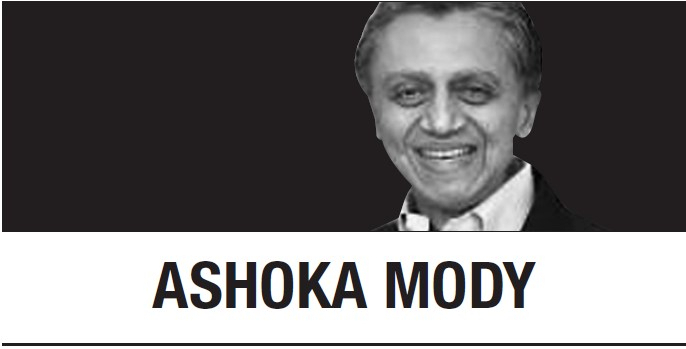[Ashoka Mody] The slow death of India’s brief secular democracy
By Korea HeraldPublished : Jan. 23, 2024 - 05:30

On Jan. 22, Indian Prime Minister Narendra Modi will preside over the consecration of the Ram Temple in Ayodhya, Uttar Pradesh. Executive power will symbolically fuse with the Hindu religion -- harking back to myths of Indian rulers as incarnations of Supreme Lord Vishnu -- at the former site of the Babri Mosque, demolished by self-styled “angry Hindus” in 1992.
Indian children will celebrate the mythological Lord Ram. State-owned railways have promised to transport more than a thousand trainloads of pilgrims to Ayodhya, boosting tourism-related stock prices. Possibly a hundred private jets will fly in tycoons and notables. This ecstatic moment will cap an unyielding century-long journey to a vision forged by the anarchist ideologue Vinayak Damodar (Veer) Savarkar.
In his 1923 booklet, Hindutva, Savarkar presented an audacious Hindu-centric Indian nationalism. Breaking from the Hindu religion’s message of transcendental equality, he divided the world between friends -- those rooted in India through ancestry and devotion to the Fatherland -- and all others, who were deemed enemies. (A decade later, the German jurist and prominent Nazi Party member Carl Schmitt advocated the same friend-versus-enemy conception of politics.)
In 1925, the Savarkar-inspired Rashtriya Swayamsevak Sangh (RSS) became Hindutva’s military wing. Recruiting and training youth in martial disciplines and the glories of the Indian past, it promoted political violence and intolerance inherent in the friend-enemy distinction. Perhaps the most famous RSS graduate is Modi.
Initially, the Indian National Congress, led by Mahatma Gandhi, countered Hindutva’s appeal to India’s Hindu majority with a unifying secular ideology anchored in freedom from British colonial rule. But Hindutva forces saw Gandhi’s call for religious harmony as pandering to Muslims, and in 1948, a Savarkar-inspired ideologue assassinated him.
Jawaharlal Nehru, independent India’s first prime minister, promoted a progressive secular Indian ideal precariously held together by the hope for material and social progress. But after Nehru’s death in 1964, communal forces within and outside the Congress party gained momentum. Secular ideals suffered a major blow on April 19, 1976, when the younger son of Prime Minister Indira Gandhi used the dictatorial powers of emergency rule to brutalize Muslims. The day began with humiliating forced sterilizations near Delhi’s Jama Masjid and culminated in a massacre of slumdwellers resisting eviction in neighboring Turkman Gate.
As Muslim electoral support for Congress waned, Gandhi shifted her focus to the Hindu vote, thus opening the door wider for hardline Hindutva forces. She established backchannel communications with the RSS, and increased her use of Hindu symbols as Hindu-Muslim riots became more frequent in the early 1980s. Her pandering to Hindus in the Jammu and Kashmir elections, and her support for the Sikh militant Sant Bhindranwale in Punjab, further stoked Hindu identity politics. After her assassination by her Sikh bodyguards, the anti-Sikh violence orchestrated by Congress leaders catalyzed mobs of unemployed -- even unemployable -- men as Hindu nationalism’s foot soldiers.
Two key developments in the 1980s gave vivid reality to Savarkar’s vision of an India united by politicized Hinduism. In 1983, emboldened hardline Hindutva forces launched the “Ekatmata Yatra,” loosely defined as a “march to celebrate India’s one soul.” Organized by the Sangh Parivar (the umbrella term for Hindutva groups), multiple processions crisscrossed the country with Hindu emblems. In 1987-88, instructed by Prime Minister Rajiv Gandhi (Indira Gandhi’s older son), state-owned television Doordarshan serialized the much-loved Ramayana epic, which spawned a Rambo-like iconography of Lord Ram as Hindutva’s avenger.
Rajiv Gandhi also reignited the Hindu-Muslim contest for the site on which the sixteenth-century Babri Masjid stood. With Hindu zealots claiming that it was Lord Ram’s birthplace, Gandhi declared himself a champion of Hindu ideals and opened its gates, sealed since 1949 to contain communal passions. Then, in December 1992, Prime Minister P.V. Narasimha Rao’s Congress-led government dithered as frenzied Hindu mobs demolished Babri Masjid, triggering bloody riots and further bolstering the Hindutva cause.
Only 16 years separated the Turkman Gate massacre of Muslims in 1976 to their humiliation with the demolition of Babri Masjid in 1992 and its gruesome aftermath. Indian secularism was a receding shadow. The Hindutva juggernaut was marching ahead, triumphing in May 2014, when the Bharatiya Janata Party -- the political face of Hindutva -- gained a large parliamentary majority under Modi’s leadership. With the hardliners in power, Hindu mobs have gained license to lynch Muslims and assassinate anti-Hindutva opponents.
Matters could worsen. Hindu symbols and sentiments have infused state conduct ominously. Modi has helped establish Savarkar as a demigod. Promoting a Hindu theocratic state, he inaugurated the new parliament building in a ceremony overshadowed by Hindu ritualism. In November 2019, the Supreme Court, despite the absence of historical evidence of Lord Ram’s birth on the Babri Masjid site, authorized the Ram Temple’s construction in deference to Hindu “faith and belief.” Similarly, the chief justice recently presented himself as a modern Savarkar, remarking that flags flying atop Hindu temples represent the Constitution of India’s unifying force.
Meanwhile, hate-filled H-pop and cinema are normalizing Hindutva’s hard edge, as are Congress’s “soft Hindutva tactics.”
Although Hindutva’s rise over the past century has occasionally paused, it has never reversed. Indeed, it has accelerated at critical moments when putatively secular politicians used religion to gain an electoral advantage. They gave oxygen to Hindutva’s potent friend-versus-enemy narrative, which gradually overwhelmed the secular interlude of early post-independence India.
Today, violent Hindutva -- far removed from the peaceful tenets of Hinduism -- has infiltrated politics and culture, with elite acquiescence. As Modi assumes the persona of a priest-like ruler on Monday, the idea of a theocratic India appears impervious to secular opposition, regardless of the outcome of the general election set for April and May.
Ashoka Mody
Ashoka Mody is a visiting professor of international economic policy at Princeton University. -- Ed.
(Project Syndicate)
-
Articles by Korea Herald



















